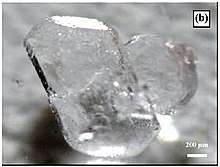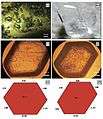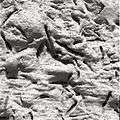Meridianiite
Meridianiite is the mineral consisting of magnesium sulfate undecahydrate, MgSO
4•11H
2O. It is colorless transparent crystalline salt that precipitates from solutions saturated in Mg2+ and SO42− ions at temperatures less than 2 ˚C. [3]. The synthetic compound was formerly known as Fritzsche's salt.[3]
| Meridianiite | |
|---|---|
 Meridianiite crystals displaying blocky, triclinic, crystal forms. | |
| General | |
| Category | Sulfate minerals |
| Formula (repeating unit) | Magnesium sulfate 11 hydrate MgSO4•11H2O |
| Strunz classification | 7.CB.90 |
| Crystal system | Triclinic |
| Crystal class | Pinacoidal (1) (same H-M symbol) |
| Space group | P1 |
| Unit cell | a = 6.7459 Å b = 6.8173 Å c = 17.299 Å; α = 88.137°, β = 89.481°, γ = 62.719° Z = 2 |
| Identification | |
| Formula mass | 318.55 g/mol |
| Color | Colorless or white |
| Crystal habit | Needle-shaped to broad flat crystals |
| Tenacity | Brittle |
| Luster | Vitreous – dull |
| Streak | White |
| Diaphaneity | Transparent |
| Specific gravity | 1.512 |
| Melting point | At temperatures above 2 ˚C |
| Solubility | Highly soluble in water |
| References | [1][2] |
Meridianiite is a naturally occurring mineral species found on Earth in a variety of environments including sea ice, crusts and efflorescences in coal/metal mines, cave systems, oxidized zones of sulfide deposits, salt lakes/playas and Antarctic ice-cores.[4][3] It is commonly associated with other evaporite minerals such as epsomite, mirabilite, halides, and other sodium-magnesium-sulfates. There is some evidence that it was once present on the surface of Mars, and may occur in several bodies of the Solar system.[3] As of 2012, it was the only undecahydrate sukfate known.[5]
Properties
Meridianiite belongs to the triclinic crystal system, having cell parameters a = 6.7459 Å, b = 6.8173 Å, c = 17.299 Å, a density = 1.512 g/cm-3, x-ray diffraction peaks at d-spacing's = 5.73, 5.62, 5.41, 4.91, 4.85, 2.988, 2.958 (highest intensity), and 2.940, and is IR active. It produces needle-shaped to broad flat crystals that are clear to colorless-white.[4]
Meridianiite decomposes incongruently above 2 °C to produce epsomite (MgSO4•7H2O) and water.[3] Meridaniite and water have an eutectic point at −3.9°C and 17.3% (mass) of MgSO4.[4][5]
Meridianiite can incorporate large proportions of other divalent cations (whose sulfates themselves do not seem to form an undecahydrate) as solid solution, without changes to its structure. These include nickel (up to about 27% of the cations replaced), zinc (up to about 27%), cobalt (up to about 67%), manganese(II) (about 62%), copper (about 8%), and iron(II) (about 8%).[5]
At pressures of about 0.9 GPa and at 240 K, meridianiite decomposes into a mixture of ice VI and the enneahydrate MgSO
4•9H
2O,[6]
Discovery
In 1837 by C. J. Fritzsche described what he interpreted as magnesium sulfate dodecahydrate, based on the weight loss during dehydration to the anhydrous salt.[7] The substance was referred to as "Frizsche's salt" and not formally given a mineral name or designation.[4]
The crystal structure was later resolved by Peterson and Wang in 2006, revealing that it belonged to the triclinic crystal system, and each formula unit included 11 molecules of water, not 12.[3]
The name "meridianite" is derived from Meridiani Planum, the locality on Mars where it is believed to have existed in the past. The mineral species and the name were approved by the Commission on New Mineral Names and Mineral Nomenclature of the International Mineralogical Association in November 2007.[1]
Occurrence on Earth
Meridianiite has been found to occur on the surface of the ice layer formed in winter over the ponds known as Basque Lakes, in Canada. The water in those ponds has a high concentration of magnesium sulfate and other salts. Water seeping through the ice layer evaporates at the surface leaving a deposit of crystalline meridianiite.[3]
Meridianiite has also been detected in sea-ice collected in winter from the saline Lake Saroma in Japan, as well as in ice cores from Dome Fuji station, Antarctica, near the summit of the east Dronning Maud Land plateau.[4]
Extraterrestrial occurrence
Imagery of the massive sulfate deposits sent back by the NASA Opportunity Rover in Meridiani Planum show numerous needle-shaped void spaces throughout the deposit. The now empty angular holes are interpreted as being cavities once filled by a highly soluble mineral species, most likely a magnesium sulfate. These cavities are observed to closely match the crystal habit of meridianiite, and have been proposed as sites where crystals of meridianiite were located, having subsequently dissolved when environmental conditions rendered the crystal unstable. Due to the decomposition of meridianiite to 70% epsomite and 30% water, it has been proposed that meridianiite may represent a periodic reservoir of water near the Martian surface. During warmer periods in Mars’ history it is possible that triggered melting of this mineral may help explain the occurrence of some of the chaotic, and short lived, surface-water episodes throughout Martian history.
Remote sensing of other planetary bodies has also indicated the presence of numerous hydrated mineral species, including sulfates, near various planetary surfaces, a prominent example of which is Jupiter’s moon Europa. The relatively smooth, and very young surface of Europa has been interpreted as evidence for a putative ocean beneath the moons icy surface, and is therefore suggestive of liquid brine at depth. Due to the cryospheric conditions present on Europa it is likely that any magnesium sulfate minerals present, and in contact with liquid water, would inherently occur as meridianiite, and thus, it may make up an important mineral phase, and liquid water reservoir at depth.[3]
Gallery
 Figure 1. (a, b, d) Optical images of meridianiite, MgSO4•11H2O. Courtesy Genceli et al. 2007.
Figure 1. (a, b, d) Optical images of meridianiite, MgSO4•11H2O. Courtesy Genceli et al. 2007. Figure 2. Sampling of meridianiite off a wooden post. Courtesy R. Peterson 2010.
Figure 2. Sampling of meridianiite off a wooden post. Courtesy R. Peterson 2010. Figure 3. Type occurrence of meridianiite at Basque Lake No. 1. Courtesy R. Peterson 2010.
Figure 3. Type occurrence of meridianiite at Basque Lake No. 1. Courtesy R. Peterson 2010. Figure 4. Meridianiite mineral type locality; Basque Lake No. 1 as seen in winter 2007. Courtesy R. Peterson 2010.
Figure 4. Meridianiite mineral type locality; Basque Lake No. 1 as seen in winter 2007. Courtesy R. Peterson 2010. Figure 5. Long needle-shaped crystal void cavities as observed by the NASA Opportunity Rover at Meridiani Planum, Mars. Image courtesy R. Peterson 2010, and NASA.
Figure 5. Long needle-shaped crystal void cavities as observed by the NASA Opportunity Rover at Meridiani Planum, Mars. Image courtesy R. Peterson 2010, and NASA. Figure 6. Temperature vs. weight % MgSO4 diagram depicting the stability ranges of the various pure magnesium sulfate hydrated salts. Courtesy R. Peterson 2010.
Figure 6. Temperature vs. weight % MgSO4 diagram depicting the stability ranges of the various pure magnesium sulfate hydrated salts. Courtesy R. Peterson 2010. Figure 7. X-Ray diffraction data obtained using a Cobalt source for the magnesium sulfate hydrate, Meridianiite. The dotted line is representative of the ideal intensity and spectral pattern of meridianiite. Courtesy R. Peterson 2010.
Figure 7. X-Ray diffraction data obtained using a Cobalt source for the magnesium sulfate hydrate, Meridianiite. The dotted line is representative of the ideal intensity and spectral pattern of meridianiite. Courtesy R. Peterson 2010. Figure 8. Infrared absorption of meridianiite. Courtesy R. Peterson 2010.
Figure 8. Infrared absorption of meridianiite. Courtesy R. Peterson 2010.
References
| Wikimedia Commons has media related to Meridianiite. |
- Mindat.org
- Webmineral.com
- R. C. Peterson, W. Nelson, B. Madu, and H. F. Shurvell (2007): "Meridianiite: A new mineral species observed on Earth and predicted to exist on Mars". American Mineralogist, volume 92, issue 10, pages 1756–1759. doi:10.2138/am.2007.2668
- F. E. Genceli, S. Horikawa, Y. Iizuka, S. Toshimitsu, T. Hondoh, T. Kawamura, and G-J. Witkamp (2009): "Meridianiite detected in ice". Journal of Glaciology, volume 55, issue 189, pages 117–122.DOI: https://doi.org/ doi:10.3189/002214309788608921
- A. Dominic Fortes, Frank Browning, and Ian G. Wood (2012): "Cation substitution in synthetic meridianiite (MgSO4·11H2O) I: X-ray powder diffraction analysis of quenched polycrystalline aggregates". Physics and Chemistry of Minerals, volume 39, issue , pages 419–441. doi:10.1007/s00269-012-0497-9
- A. Dominic Fortes, Kevin S. Knight, and Ian G. Wood (2017): "Structure, thermal expansion and incompressibility of MgSO4·9H2O, its relationship to meridianiite (MgSO4·11H2O) and possible natural occurrences". Acta Crystallographica Section B: Structureal Science, Crystal Engineering and Materials, volume 73, part 1, pages 47-64. doi:10.1107/S2052520616018266
- C. J. Fritzsche (1837): "Ueber eine neue Verbindung der schwefelsauren Talkerde mit Wasser". Poggendorff's Annalen Der Physik Und Chemie, now Annalen Der Physik, volume 118, issue 12, pages 577–580. doi:10.1002/andp.18371181211
- F. E. Genceli, M. Lutz, A.L. Spek, and G-J. Witkamp (2007): "Crystallization and characterization of a new magnesium sulfate hydrate MgSO4•11H2O." Crystal Growth & Design, 7, pages 2460–2466.
- J. B. Dalton (2003): "Spectral behavior of hydrated sulfate salts: Implications for Europa mission spectrometer design." Astrobiology, 3, pages 771–784.
- R. C. Peterson and R. Wang (2006): "Crystal molds on Mars: Melting of a possible new mineral species to create Martian chaotic terrain". Geology, 34, pages 957–960.
- A. D. Fortes, I. G. Wood, and K. S. Knight (2008). "The crystal structure and thermal expansion tensor of MgSO4•11D2O (meridianiite) determined by neutron powder diffraction". Physics and Chemistry of Minerals, 35, pages 207–221.